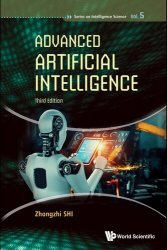Advanced Artificial Intelligence, 3rd Edition
- Добавил: literator
- Дата: 9-11-2024, 07:16
- Комментариев: 0
 Название: Advanced Artificial Intelligence, 3rd Edition
Название: Advanced Artificial Intelligence, 3rd EditionАвтор: Zhongzhi Shi
Издательство: World Scientific Publishing
Год: 2025
Страниц: 391
Язык: английский
Формат: pdf (true)
Размер: 22.8 MB
This third edition comprehensively captures the cutting-edge research achievements of Artificial Intelligence (AI). Topics are thoroughly revised and updated, presenting the latest techniques and strategies to address the impending challenges facing computer scientists today.
Artificial Intelligence is a branch of Computer Science and is a discipline to study machine intelligence that uses artificial methods and techniques, develops intelligent machines or intelligent systems to emulate, extend, and expand human intelligence, and realizes intelligent behavior. Artificial Intelligence in general can be divided into symbolic intelligence and computational intelligence. Symbolic intelligence is the traditional symbolic Artificial Intelligence; it is the basis of physical symbol system to study the knowledge representation, acquisition and reasoning process. Use of knowledge to solve problems is basic, the most important feature of the current symbol intelligence, so people often put the current stage of Artificial Intelligence known as knowledge engineering. Knowledge engineering research emphasizes on knowledge information processing methods and technologies, and promotes the development of Artificial Intelligence.
Machine Learning is the study of how computers can simulate or implement human learning behavior to acquire new knowledge or skills, and reorganize existing knowledge structures to continuously improve their own performance. Only by allowing computer systems to have human-like learning capabilities can it be possible to achieve human-level Artificial Intelligence. Machine Learning is one of the core issues in Artificial Intelligence research and is a very active research field in current Artificial Intelligence theoretical research and practical applications. Common machine learning methods include inductive learning, analogy learning, analytical learning, reinforcement learning, genetic algorithm, and connection learning. Deep Learning is a new field in Machine Learning research. It imitates the analysis and learning mechanism of human brain neural networks to interpret images, sound, and text data. Any progress in Machine Learning research will promote the improvement of Artificial Intelligence.
The third edition is separated into 12 chapters. Chapter 1 is the introduction; over the past more than 60 years, the development of Artificial Intelligence has gone through the formation period, symbolic intelligence, and data intelligence periods. Chapter 2 discusses logic for Artificial Intelligence with a more systematic discussion of non-monotonic logic and agent-related logic systems. Chapter 3 expounds on reasoning; it is a mental activity that aims to arrive at a conclusion in a rigorous way. Causal reasoning is generally considered a form of inductive reasoning. Chapter 4 describes game theory which is the study of models of strategic interactions among rational agents. Machine Learning is the core of the current Artificial Intelligence research, but also knowledge discovery, data mining, and learnability are important bases for this book with Chapter 5 for statistical learning. Chapter 6 discusses deep learning. Chapter 7 presents reinforcement learning. Chapter 8 describes transfer learning. Chapter 9 focuses on Federated Learning. Artificial General Intelligence (AGI) could learn to accomplish any intellectual task that human beings or animals can perform; it is a hot topic. Chapter 10 summarizes the most possible approaches. Chapter 11 discusses crowd computing, which is a new collaborative computing paradigm for heterogeneous agents in human–machine–physical integration environments. Chapter 12 discusses AI for science and promotes scientific progress and technical development.
The useful reference text benefits professionals, academics, researchers, senior and graduate students in the information field and related tertiary specialties.
Readership: Researchers, professionals, academics and graduate students in Artificial Intelligence, Machine Learning and pattern recognition.
Contents:
Скачать Advanced Artificial Intelligence (3rd Edition)
[related-news] [/related-news]
Внимание
Уважаемый посетитель, Вы зашли на сайт как незарегистрированный пользователь.
Мы рекомендуем Вам зарегистрироваться либо войти на сайт под своим именем.
Уважаемый посетитель, Вы зашли на сайт как незарегистрированный пользователь.
Мы рекомендуем Вам зарегистрироваться либо войти на сайт под своим именем.

